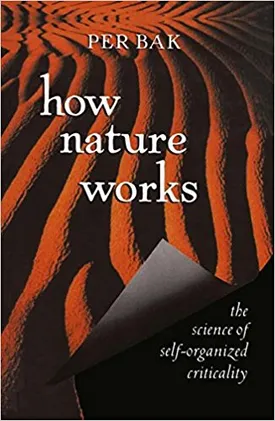How Nature Works: The Science of Self-organized Criticality by Per Bak
Per Bak's book “How Nature Works: The Science of Self-Organized Criticality” attempts to answer why natural systems tend to continually evolve, self-organize and reach a critical state. The author examines complex systems such as the solar system, earthquakes, neural networks and economic systems, and outlines an ideas of self-organized criticality (SOC) to explain the nature and evolution of such systems.
The book starts off with a discussion on the theory of self-organized criticality (SOC) and how it can be applied to natural systems in order to understand their long-term, large-scale behavior. SOC is based on the idea that systems which are subjected to repeated external perturbations will continue to evolve and reach a critical state which, in turn, is the driving force for further evolution. The author goes on to explain that this critical state is the optimal condition for natural systems, allowing them to adapt and fine-tune themselves in order to achieve higher efficiency. Such constant evolution can only be achieved in systems which are able to maintain a certain degree of instability.
The book then moves on to examine the nature of numerous natural systems, showing how SOC can help to explain the behavior of earthquakes and avalanches, ecosystems, neural networks, economics, etc. For example, in chapter four the author looks at some simple models and investigates how an avalanche of sand particles on a slope can be used to illustrate SOC. He explains how a seemingly random motion of the sand particles can build up to a critical point and then trigger an avalanche, releasing large amounts of energy. This is linked to how avalanches form in the natural world and how they can be used to illustrate how self-organized criticality helps to promote the evolution of such systems.
In applying the theory of self-organized criticality, Per Bak argues that many natural phenomena can be explained by a single, general model. He explains that, by understanding the behavior of natural systems and how SOC helps to drive this process, we can develop better models for understanding the world, and for predicting and managing complex phenomena.
The book ends with a brief overview of current research into self-organized criticality and its applications to a vast range of modern systems and their applications. From brain networks to economics, the theories of Per Bak offer a convincing argument for why studying the dynamics of SOC can help to explain the evolution of complex systems.
Overall, “How Nature Works: The Science of Self-Organized Criticality” offers an in-depth and accessible guide to understanding the evolution of natural systems and their behavior. By presenting clear and logical arguments and writing in an engaging style, the author's aim of exploring and outlining the complexities of self-organized criticality is achieved. The book helps to expand the scope of current scientific understanding and provides a platform for further exploration into the processes at work in the natural world.

